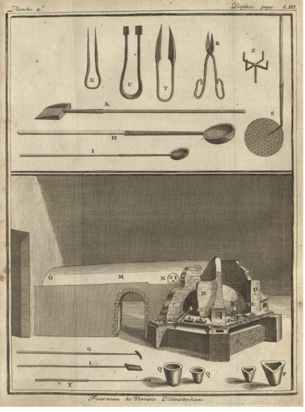Sign up for FlowVella
Sign up with FacebookAlready have an account? Sign in now
By registering you are agreeing to our
Terms of Service
Loading Flow



KEY
Find the letter for each tool to learn more
Top row:
X. Shaping tool to extend or bend glass like a rope
U. Borsella dei fiori: shaping tool to create the volume of glass in a floral shape
T. Borsella: shaping tool used to enlarge or reduce the volume of glass
R. Tagliante: scissors used to cut the glass
Bottom rows:
K. Large shovel to catch falling glass particles
H. Large copper spoon used for transporting powder and cinders into the furnace
I. Small spoon used for stirring the mixture in the furnace and pouring materials
from one hole to another
S. Slotted spoon used to select alkali powder for glass recipe
An Italian competition in glassmaking existed throughout the early modern period, between Florence and Venice. Florentine glass has long been used for making lenses and observational tools. Venetian glass, instead, focused more on the artistry of decoration, an interest that spread to the Netherlands, and especially Amsterdam, where the depicted furnace is situated. In Christopher Merret's preface to this edition of Neri's book, he praises glass for its tremendous utility in science as a practicing physician. The making of lenses, prisms, thermometers, and barometers all depends on the technical skill of the glassblower, an expertise of 17th- and 18th-century Florentine glassmakers.

1

2

3

4

5

6

7

8

9

10

11

12

13

14

15

16

17

18

19

20

21

22

23

24

25

26

27

28

29

30

31

32

33

34

35

36

37

38

39

40

41

42

43

44

45

46

47

48

49

50

51

52

53

54

55

56

57

58

59

60

61

62

63

64

65

66

67

68

69

70

71

72

73

74

75

76

77

78

79

80

81

82

83

84

85

86

87

88

89

90

91

92

93

94

95

96

97

98

99

100

101

102

103

104

105

106

107

108

109

110

111

112

113

114

115

116